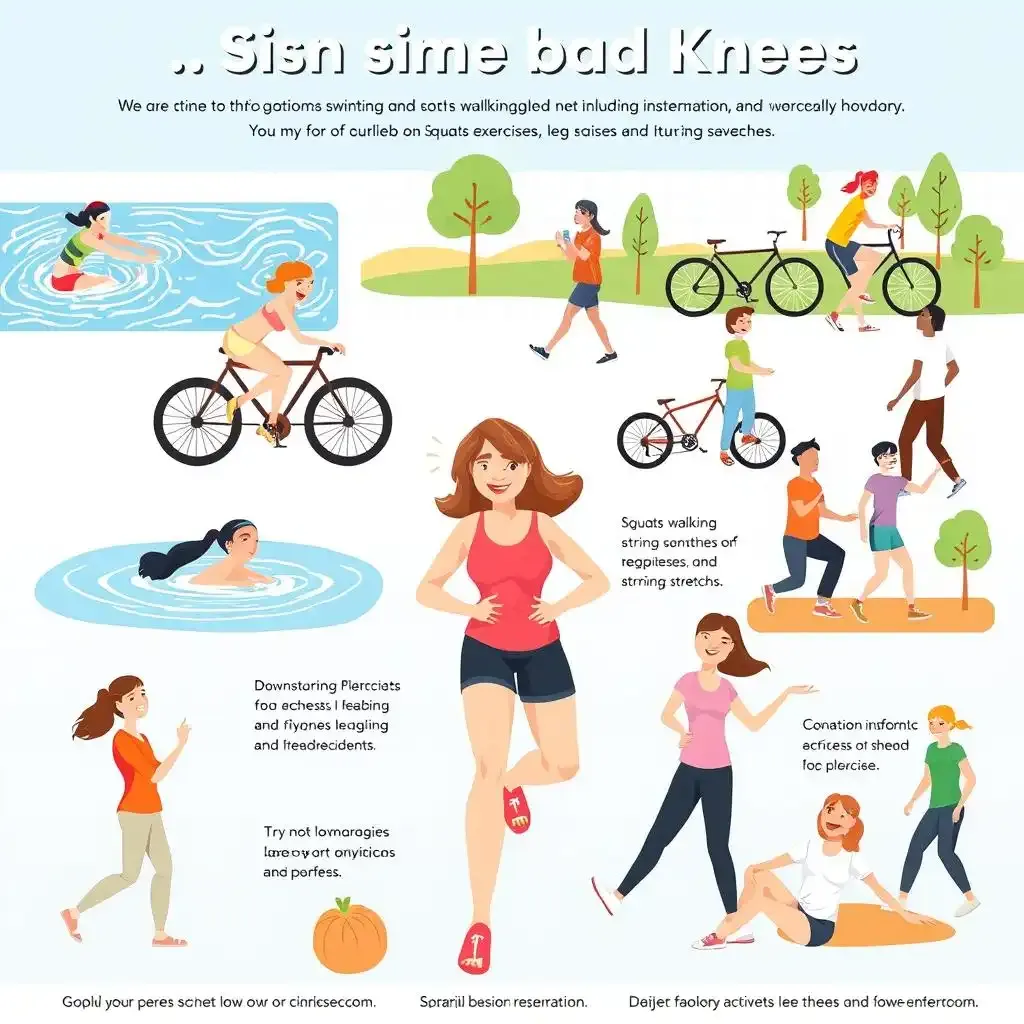Table of Contents
bad knees. Just the phrase makes you wince, doesn't it? Whether it's a nagging ache after a long walk or a sharp pain that stops you in your tracks, knee problems are incredibly common. Millions suffer from bad knees, and the reasons can range from simple overuse to serious underlying conditions. This article will explore the various causes of bad knees, from minor injuries to arthritis and other conditions. We'll explore into when you should see a doctor, what treatments are available, and importantly, how you can manage your bad knees and improve your quality of life. We'll cover everything from simple exercises to lifestyle changes that can make a real difference. So, if you're ready to understand your bad knees better and take control of your pain, let's get started. We'll understand the mysteries behind those troublesome knees and empower you to find solutions.
Understanding Bad Knees: Causes and Common Problems
Hey there, fellow knee-pain sufferers! Let's talk about bad knees. It's like, the bane of my existence – or at least, it felt that way before I learned a thing or two. Think of your knees as amazing hinges, constantly working to let you move around. But just like any hinge, they can get rusty, creaky, and plain old broken. So many things can cause bad knees; it's a bit like a choose-your-own-exploration book of ouchies.
One common culprit? Injuries! I remember twisting my knee playing soccer as a kid – that was a fun time (said no one ever). A simple sprain can cause knee pain, and more serious issues like torn ligaments or cartilage are also possible. Overuse is another big player. Ever run a marathon without any training? Yeah, me neither, but I've seen what that does to people's knees! That constant pressure takes its toll. If you are experiencing knee discomfort, you might want to check out our article on knee discomfort for more information.
Cause | Description | Example |
|---|---|---|
Injury | Sudden trauma to the knee | Twisting your knee while playing sports |
Overuse | Repeated stress on the knee | Running long distances without proper training |
Arthritis | Inflammation of the joints | Osteoarthritis, rheumatoid arthritis |
Then there's arthritis, a sneaky villain. It's like a slow burn, causing inflammation in your knee joints. This leads to stiffness, swelling, and that familiar throbbing pain. Arthritis comes in many forms – osteoarthritis, rheumatoid arthritis, and more – each with its own quirks. Learning more about arthritis can help you understand the condition better. If you're dealing with severe pain, you may want to look at our guide to knee pain relief.
Beyond those big three, there are other issues that can cause bad knees. Bursitis, for instance, is an inflammation of the fluid-filled sacs that cushion your knee joint. Think of it like tiny water balloons that get irritated. Tendinitis is another one – an inflammation of the tendons that connect your muscles to your bones. It's like a stubborn muscle cramp that just won't let go. These conditions often result from repetitive movements or overuse, so it's important to listen to your body and take breaks when needed.
- Injuries (sprains, tears)
- Overuse (running, jumping)
- Arthritis (osteoarthritis, rheumatoid arthritis)
- Bursitis (inflammation of fluid-filled sacs)
- Tendinitis (inflammation of tendons)
So what's the takeaway? Bad knees are a common problem with many possible causes. It's important to pay attention to your body, rest when needed, and don't hesitate to seek professional help if the pain is persistent or severe. Sometimes, a little TLC (tender loving care) is all you need, but other times, you might need to see a doctor. If you're searching for more information on painful knees, check out our detailed article on painful knees.
Remember, I'm not a doctor! This information is for educational purposes only. Always consult with a healthcare professional for diagnosis and treatment of any medical condition, especially if you are experiencing persistent or severe knee pain. You can also find some additional information on managing knee pain in our other articles.
"Prevention is better than cure. Listen to your body!" - Anonymous Wise Person (probably)
Bad Knees: When to See a Doctor and Treatment Options
Bad Knees When To See A Doctor And Treatment Options
Okay, so you've got bad knees. Bummer, right? But don't panic! Knowing when to see a doctor is key. Think of your knees like a really important car part – if something's seriously wrong, you wouldn't just keep driving, would you? You'd take it to a mechanic. Same goes for your knees.
If your knee pain is severe, persistent (lasting weeks despite trying home remedies), or is accompanied by swelling, stiffness, locking, or instability, it's time to see a doctor. Don't just pop some ibuprofen and hope for the best – sometimes, that pain is telling you something serious is going on. Ignoring it could lead to more problems down the road. Check out our guide to for some immediate relief tips, but remember, this is not a substitute for professional help!
Symptom | Severity | Action |
|---|---|---|
Mild pain | Occasional, manageable | Rest, ice, over-the-counter pain relief |
Moderate pain | Frequent, limits activity | See a doctor, consider physical therapy |
Severe pain | Constant, debilitating | Seek immediate medical attention |
Doctors can diagnose the problem – is it arthritis, a torn meniscus, or something else entirely? – and recommend the right treatment. That might include physical therapy (think exercises to strengthen your leg muscles – super important!), medication (to reduce pain and inflammation), or even surgery in some cases. Physical therapy can help you regain strength and flexibility, making everyday activities easier. If you're looking for more information on managing ongoing pain, check out our article on .
- Physical Therapy
- Medication (pain relievers, anti-inflammatories)
- Surgery (in severe cases)
- Injections (cortisone shots)
Remember, early intervention is key. The sooner you get help, the better your chances of a full recovery. Don't let those bad knees sideline you! It's all about finding the right treatment plan for *your* specific situation. For some more tips on dealing with knee discomfort, please check out our article on .
"The body heals itself. The doctor just helps it do what it already wants to do." – Unknown
Living with Bad Knees: Management Strategies and Exercises
Living With Bad Knees Management Strategies And Exercises
Living with bad knees? Yeah, I get it. It feels like your knees are plotting against you, staging a slow-motion rebellion against your plans for a fun day. But before you resign yourself to a life of limping and whining, let's talk strategies. Think of your knees as grumpy old friends – they need a little TLC (tender loving care) to get back in top shape. And guess what? A little bit of exercise is actually your friend here. It’s not about intense workouts, but smart, gentle movement that keeps those joints happy. For some more immediate relief ideas, check out our guide to .
First things first: listen to your body. If something hurts, stop! This isn't a competition. Pushing through pain will only make things worse. Instead, focus on low-impact activities that don't put too much stress on those poor knees. Swimming is amazing; it's like a weightless workout. Cycling is another good option – find a stationary bike if you're not feeling super stable. And walking is great, but start slow and gradually increase the distance. Remember to avoid high-impact stuff like jumping jacks or running until your knees are feeling a little more cooperative. If you’re looking for more information on managing ongoing pain, check out our article on .
Activity | Benefits | Caution |
|---|---|---|
Swimming | Low impact, full body workout | Start slowly, avoid overexertion |
Cycling | Low impact, strengthens leg muscles | Use proper bike fit for comfort |
Walking | Improves circulation, strengthens knees | Start slowly, use good posture |
Strengthening exercises are your secret weapons. Think of your leg muscles as the bodyguards for your knees. Strong muscles provide support and stability, reducing strain on the joints. Simple exercises like squats (modified if needed), leg raises, and hamstring stretches are great starting points. You can find tons of videos online showing how to do these safely. Remember to start slowly and gradually increase the intensity and repetitions as you get stronger. If you're looking for ways to deal with knee discomfort, you might want to check out our article on for more information.
Don't forget about stretching! Tight muscles can put extra pressure on your knees. Regular stretching improves flexibility and range of motion, reducing stiffness and pain. Focus on stretches for your hamstrings, quads, and calves. Holding each stretch for 15-30 seconds is usually enough. And remember to breathe! Deep, controlled breathing helps relax your muscles and reduce tension. For some more tips on dealing with pain in your knees, please check out our article on knees are in pain.
- Hamstring stretches
- Quadriceps stretches
- Calf stretches
- Gentle knee bends
Weight management is another key factor. Extra weight puts extra strain on your knees. Even a small amount of weight loss can make a big difference. Talk to your doctor or a registered dietitian about creating a healthy eating plan that works for you. Remember, it's not about drastic changes; small, sustainable changes are more likely to stick. For some more immediate relief ideas, check out our guide to painful knee pain.
"A healthy mind in a healthy body." – Ancient Wisdom
Taking Charge of Your Knee Health
Dealing with bad knees can be challenging, but it's not a sentence to a life of pain and immobility. By understanding the potential causes, knowing when to seek professional help, and implementing effective management strategies, you can significantly improve your comfort and mobility. Remember, proactive care, regular exercise, and a healthy lifestyle are key to long-term knee health. Don't let bad knees control your life; take control of your knee health today.